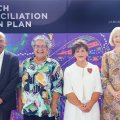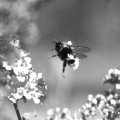People living on city limits and around regional urban centres are more likely to vote for One Nation in the Federal election, according to an analysis of the recent Queensland election by the Australian Housing and Urban Research Institute at the University of Queensland.
In a paper for the journal People and Place, Professor of Geographical Sciences and Planning Robert Stimson and senior research officer Rex Davis analysed the June 13 result using a new approach involving a comparison of census data and electoral results at the smallest possible level.
The researchers assessed demographic, social and economic data collected at the 1996 census as a determinant of voting behaviour, and in particular a vote for One Nation. They matched the results from 1647 polling booths with the 6448 census collector districts across Queensland.
Professor Stimson said the study revealed the main factor in the One Nation vote was what he termed the "urban fringe" effect.
"Generally, the One Nation primary vote is strongest at the edge of metropolises and the regional urban centres and in their hinterlands," he said.
"The level of One Nation support goes up rapidly above 15 percent in areas with combinations of high unskilled and blue-collar workers, high levels of home ownership, and a high incidence of members of fundamentalist Christian religions, and high levels of population mobility.
"Conversely, the level of primary vote support for One Nation drops rapidly in areas with combinations of factors such as the proportion of overseas-born people, in particular Asians, the incidence of Aboriginal and Torres Strait Islanders, the proportion of households with higher incomes, and the incidence of renters and lone parent families.
"In Brisbane, for example, One Nation's vote within a five-kilometre radius of the central business district was almost non-existent; however, between 10 and 40 kilometres from the city centre the One Nation vote reached more than 50 percent!
"This phenomenon is consistent for Brisbane, the Gold Coast and Sunshine Coast, Townsville, Cairns, Mount Isa, Rockhampton, Bundaberg and Toowoomba," Professor Stimson said.
The researchers claim even though Queensland's politics are notoriously different from the rest of Australia, the study's results may provide a predictor of voting behaviour, particularly for One Nation, in the upcoming October 3 Federal election.
Mr Davis said the study had also revealed that One Nation was a problem for all major parties.
"The belief that One Nation is solely a problem for the National Party is a fallacy. Most of the pastoral and mixed farming heartland of the National Party does not show up as regions of high support for One Nation," he said.
"In the seat of Ipswich held by the ALP, the Eastern Heights and Raceview booths returned 43.45 percent and 41.11 percent respectively to One Nation."
For more information, contact Professor Stimson (telephone 07 3365 6307 or mobile 0411 020627) or Rex Davis (telephone 3365 9076 or mobile 0411 246 547).
o Maps showing the concentration of One Nation support are available through Mr Davis.



